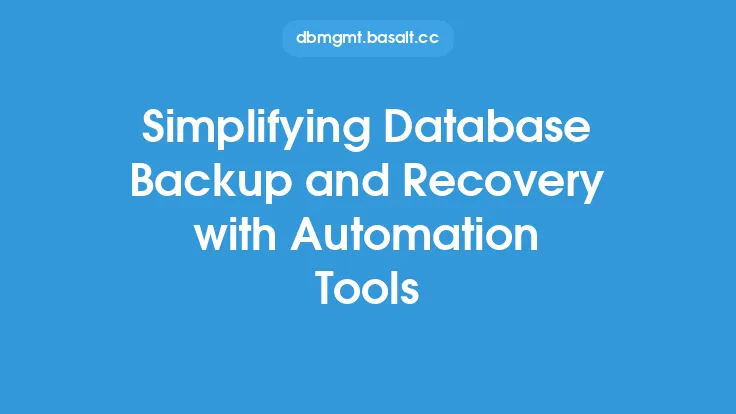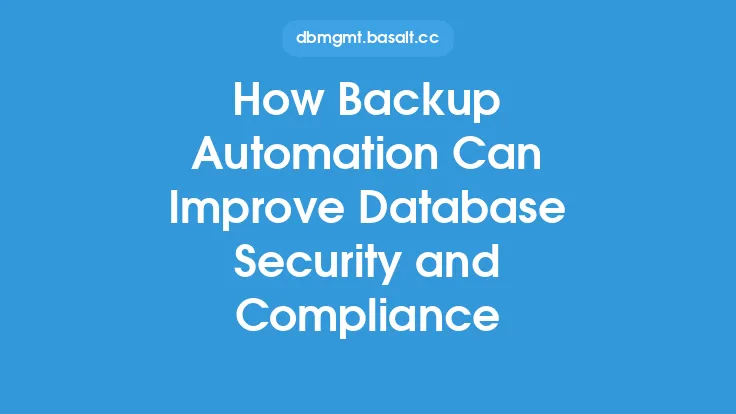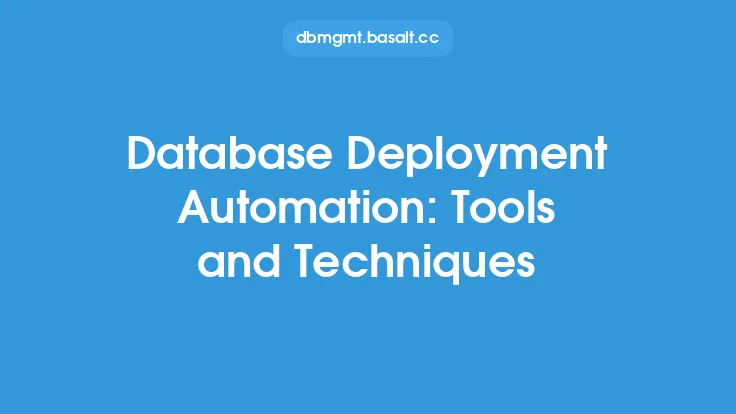Database compliance is a critical aspect of database administration, as it ensures that databases are operated in accordance with relevant laws, regulations, and industry standards. However, achieving and maintaining compliance can be a complex and time-consuming task, especially for large and complex databases. One way to simplify database compliance is through the use of automation and scripting. By automating routine tasks and using scripts to enforce compliance policies, database administrators can reduce the risk of non-compliance and improve overall database security.
Introduction to Automation and Scripting in Database Compliance
Automation and scripting are essential tools for database administrators, as they enable the automation of routine tasks, such as backups, updates, and security checks. In the context of database compliance, automation and scripting can be used to enforce compliance policies, monitor database activity, and detect potential security threats. By using automation and scripting, database administrators can ensure that databases are configured and operated in accordance with relevant compliance requirements, such as data encryption, access control, and auditing.
Benefits of Automation and Scripting in Database Compliance
The use of automation and scripting in database compliance offers several benefits, including improved efficiency, reduced risk, and increased accuracy. By automating routine tasks, database administrators can free up time to focus on more strategic tasks, such as database design and optimization. Automation and scripting also reduce the risk of human error, which is a common cause of non-compliance. Additionally, automation and scripting enable database administrators to enforce compliance policies consistently across the database, reducing the risk of non-compliance and improving overall database security.
Tools and Technologies for Automation and Scripting in Database Compliance
There are several tools and technologies available for automation and scripting in database compliance, including SQL scripts, database management system (DBMS) built-in tools, and third-party automation tools. SQL scripts are a popular choice for automation and scripting, as they enable database administrators to create custom scripts that can be used to enforce compliance policies and monitor database activity. DBMS built-in tools, such as SQL Server's Policy-Based Management, also provide a range of automation and scripting capabilities. Third-party automation tools, such as Ansible and Puppet, offer a more comprehensive automation and scripting solution, enabling database administrators to automate complex tasks and enforce compliance policies across multiple databases.
Best Practices for Automation and Scripting in Database Compliance
To get the most out of automation and scripting in database compliance, database administrators should follow several best practices. First, they should identify the compliance requirements that need to be enforced, such as data encryption and access control. Next, they should select the most appropriate tools and technologies for automation and scripting, based on the specific compliance requirements and database configuration. Database administrators should also test and validate automation and scripting solutions, to ensure that they are working correctly and enforcing compliance policies as intended. Finally, they should regularly review and update automation and scripting solutions, to ensure that they remain effective and compliant with changing compliance requirements.
Common Automation and Scripting Tasks in Database Compliance
There are several common automation and scripting tasks in database compliance, including data encryption, access control, auditing, and logging. Data encryption is a critical aspect of database compliance, as it ensures that sensitive data is protected from unauthorized access. Automation and scripting can be used to enforce data encryption policies, such as encrypting data at rest and in transit. Access control is another critical aspect of database compliance, as it ensures that only authorized users have access to sensitive data. Automation and scripting can be used to enforce access control policies, such as creating and managing user accounts and permissions. Auditing and logging are also essential tasks in database compliance, as they enable database administrators to monitor database activity and detect potential security threats. Automation and scripting can be used to automate auditing and logging tasks, such as collecting and analyzing log data.
Challenges and Limitations of Automation and Scripting in Database Compliance
While automation and scripting offer several benefits in database compliance, there are also several challenges and limitations to consider. One of the main challenges is the complexity of automation and scripting solutions, which can require significant expertise and resources to implement and maintain. Another challenge is the risk of over-automation, which can lead to a lack of visibility and control over database activity. Additionally, automation and scripting solutions may not be able to keep pace with changing compliance requirements, which can lead to non-compliance and security risks. To overcome these challenges, database administrators should carefully plan and implement automation and scripting solutions, and regularly review and update them to ensure that they remain effective and compliant.
Conclusion and Future Directions
In conclusion, automation and scripting are essential tools for simplifying database compliance, as they enable database administrators to enforce compliance policies, monitor database activity, and detect potential security threats. By using automation and scripting, database administrators can improve efficiency, reduce risk, and increase accuracy in database compliance. As compliance requirements continue to evolve, it is likely that automation and scripting will play an increasingly important role in database compliance. Future directions for automation and scripting in database compliance may include the use of artificial intelligence and machine learning to improve automation and scripting capabilities, as well as the development of more comprehensive and integrated automation and scripting solutions. By staying ahead of the curve and leveraging the latest automation and scripting technologies, database administrators can ensure that their databases remain compliant and secure.





